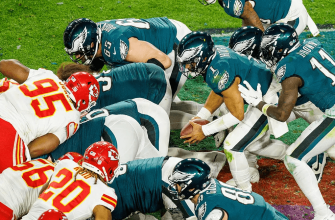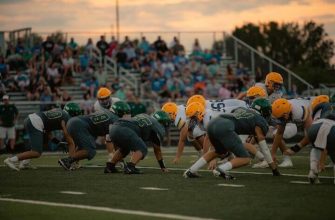Many wonder what the oldest age someone can play college football at is. College football is a beloved American tradition, with many young athletes striving to play at the highest collegiate level. However, some take more unconventional paths to joining college football teams. While the vast majority of players are between 17-23 years old, there have been rare instances of older individuals joining squads.
Determining the maximum age limit for college football requires examining NCAA rules, as well as the physical demands of the sport. Additionally, financial aid and opportunities after completing a college football career must be considered for older athletes. While no absolute cutoff age exists in the rules, social and cultural norms, as well as practical factors, constrain most players to the typical 18-23 age range. A few exceptional athletes have bucked conventions and played into their 40s and 60s, but this remains highly uncommon.
NCAA Rules
The NCAA does not specify an age limit for college football players, according to the NCAA Eligibility Center. However, NCAA rules do impose other restrictions that make it difficult for older players to participate.
All student-athletes have five years to complete four seasons of competition, beginning when they first enroll as a full-time student. This means older students who start college at a later age will have fewer years of NCAA eligibility. Players must be enrolled full-time and maintain progress toward a degree to remain eligible each year.
The NCAA also has academic requirements, including minimum GPA and standardized test scores, that may be challenging for older students who have been out of school for many years. Exceptions can be made, but the NCAA eligibility rules overall favor players who start college immediately after high school.
Upper Age Limit is Rarely Reached

While the NCAA does not impose an official upper age limit for participating in college football, very few players over the age of 30 ever play at this level. The physical demands of the sport make it challenging for most players to continue competing beyond their mid-20s. The oldest active college football players in 2024 were all in their mid to late 20s. The oldest was 27-year-old Matt Ganyard, a kicker at Texas State.
The physical toll of playing college football diminishes the talent pool dramatically past age 30. Hits from much younger and stronger athletes take their toll. Recovery time increases while speed and durability decrease. While some kickers and punters have played into their 40s in the NFL, such longevity is extremely rare in the college game. The vast majority of players retire long before reaching the theoretical upper age limit.
Physical Demands
Football is an intensely physical sport that requires strength, speed, agility, and endurance. The average college football player is 18-22 years old and in their athletic prime. As players get older, their physical abilities start to decline. According to research by DeMartini et al., college football practices and games place significant cardiovascular, thermoregulatory, and musculoskeletal demands on players. The average player runs over 1 mile per game, completes over 100 high-intensity runs, sustains over 700 head impacts, and lifts over 2 tons in the weight room per season.
Another study by Wellman et al. found that college football players experience extremely high inertial loads from impacts, accelerations, and direction changes. These inertial loads are a key driver of injury risk. Older players with declining athleticism would struggle to meet the physical demands of practices and games. Their higher injury risk could also limit their playing time and career longevity. While some exceptional older players have succeeded, the intense physical demands of football pose a significant barrier for broader participation by older athletes.
Examples of Older Players
There are some notable examples of older players who have played college football over the age of 30 in recent years. One example is Tom Thompson, who played linebacker for Allan Hancock College at age 61 in 2009, making him the oldest college football player ever. He had previously played semi-pro football in his 20s before enrolling in college decades later.
Another more recent example is Matt Ganyard, a running back who played for Southwest Baptist University at age 30 during the 2022 season. Despite his advanced age, Ganyard rushed for nearly 500 yards and 3 touchdowns. Players like Thompson and Ganyard show it’s possible for older athletes to compete at the college level under the right circumstances. Their experience and maturity can help offset any physical decline compared to younger players.
Social and Cultural Factors

There are significant social and cultural factors that lead most college football players to not continue playing past their early 20s. One major factor is the intense physical demands of the sport. Studies show that the average NFL career is just 3.3 years due to the high injury rates and physical toll on players’ bodies. As players reach their late 20s and 30s, their bodies have often already sustained years of damage and they face increasing risks of serious injury by continuing to play.
Additionally, there is immense cultural pressure for football players to conform to traditional masculine norms, which emphasize physical dominance, aggression, and mental toughness. Deviating from these norms by playing at an older age against younger competitors is seen as socially unacceptable. Players feel strong pressure to retire by their late 20s to avoid being seen as clinging to past glory days.
Finally, financial factors influence most to move on from football after college. While football can provide financial aid during college years, professional options beyond that are limited. Most recognize that continuing an unpaid college football career into their late 20s and 30s is not a viable long-term financial plan. The social and cultural pressures lead most to feel they should move on with their lives and careers as they reach their mid to late 20s.
Financial Aid Rules
Financial aid rules present a significant barrier for older students who want to play college football. According to the NCAA Guide for College-Bound Student Athletes, athletic scholarships are only guaranteed for one year at a time. This makes it difficult for older students who may need multiple years of aid to complete a degree.
Additionally, the NCAA limits student athletes to 5 years of eligibility that must be completed within 5 calendar years. This effectively sets an upper age limit, as older students are less likely to have eligibility remaining. The 5 year clock starts when the student enrolls as a full-time student, regardless of whether they play sports that term.
Older students who have been out of high school for several years would likely exceed the 5 year calendar limit before completing a degree. They would have to pay their own way without athletic aid. This financial burden makes it impractical for most older students to pursue college football.
Opportunities After College
Older college football players often have less opportunity to play professionally after finishing their college careers compared to younger players. The average age of NFL first round draft picks fell almost a full year from 2000 to 2018, dropping to around 23 years old. This suggests that younger players coming out of college may be more enticing to NFL teams.
Additionally, notes that the average age of the 2022 NFL draft class was over 24 years old, a full year older than previous years, which could negatively impact their chances of securing a roster spot. Older college players have less time to develop professionally and their bodies may show more wear and tear. Younger players may be seen as having more upside potential. So while it is possible for older college players to make it professionally, the data shows younger players tend to get more opportunities after college.
Exceptions and Special Cases

There have been some unique cases where older students have been able to play college football, often due to special circumstances:
-
In 2021, 61-year old Tom Thompson suited up as a placekicker for Austin College after returning to finish his degree over 40 years after first enrolling. As he was not receiving an athletic scholarship, the NCAA allowed him to play.
-
In 2009, 61-year old Mike Flynt played linebacker for Sul Ross State. He had played college football in the 1960s before enlisting in the Army. After retiring from a career in the military, he returned to Sul Ross State to finish his degree and received clearance from the NCAA to play.
-
Alan Moore kicked an extra point for Faulkner University in 2021 at the age of 61 after returning to finish his degree. Since he did not receive athletic financial aid, the NCAA approved his participation.
These cases show that with the right circumstances, such as not being on an athletic scholarship, the NCAA sometimes makes exceptions for older students to play college football as part of finishing a degree later in life. However, these remain rare exceptions, as the physical demands of football generally preclude widespread participation past typical college ages.
Conclusion
While the NCAA has no official upper age limit for college football players, very few athletes over the age of 30 actually play at the college level. This is due to a combination of physical, financial, and cultural factors.
The physical demands of college football make it challenging for players over 30 to keep up with 18-22 year olds at their athletic peak. The hits get harder to take and injuries take longer to recover from. Most football players start to decline athletically in their late 20s.
Financial aid rules also limit opportunities for older players. Academic scholarships are hard to come by for those who already have degrees. Athletic scholarships are rare for walk-on players over 30 years old when schools have many talented high school recruits to choose from.
Culturally, college football is seen as a sport for young adults coming out of high school. The lifestyle of balancing athletics and academics appeals more to those under 25. Players who have already started careers and families are not drawn back to college football later in life.
While stories exist of older walk-on players who earn roster spots, they are the rare exceptions. For most older athletes interested in football, semi-pro leagues or adult recreational leagues provide more realistic opportunities for continuing to play competitively. So in summary, college football remains primarily a young person’s game.








